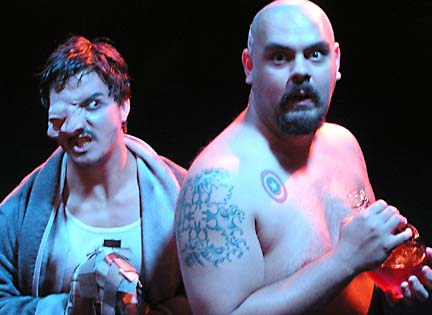

|
UH theater eyes unique
take on Greek characters
|
Odysseus -- noble hero or imperialist aggressor? That's the question student-director Ashley Larson is exploring with "The Cyclops," the second show of the Late Night Theatre season in the University of Hawaii-Manoa's Ernst Lab Theatre.
"The Cyclops" was written by Euripides in the 5th century B.C., but the central characters are probably better known than most found in ancient Greek theater, thanks to all those "sword and sandal" epics of the 1950s and early '60s. Odysseus, a Greek hero of the Trojan War, is shipwrecked on an island inhabited by a man-eating, one-eyed giant known as a Cyclops.
The Cyclops imprisons Odysseus and his crew, and eats at least one or two of them before Odysseus devises a way to escape and goes on to further adventures.
"Odysseus comes on to the island and he pretty much assumes that he can do whatever he wants with the island ... he decides he can take anything he wants," Larson says, elaborating on the idea that Odysseus' actions could seem less than heroic when seen from the viewpoint of the Cyclops and the satyrs who also live there.
"I've always loved Euripides, but the main thing about this story is that it really shows Odysseus as more of a human being, and it gives an option to display the Cyclops as not quite the monster he's portrayed as. I was trying to raise the question as to who the real monster is. There's an interesting balance of power between the two of them."
Although some versions of the story may not mention the satyrs -- part-human, part-horse -- they're an important part of Euripides' play. Larson says that although the satyrs describe themselves as the Cyclops' slaves, "he protects them, and feeds them and never hurts them."
"There's really almost a family group between the Cyclops and the satyrs," Larson says. "Odysseus comes in and breaks it up by luring the satyrs away with him by bribing them with nymphs and promises of excitement in going to see faraway places."
GREEK PLAYWRIGHTS and storytellers often portrayed satyrs as lusty souls who liked to drink but who were not particularly clever or deep thinkers, sometimes insolent, but definitely lovers rather than fighters.
And although it may seem strange that the satyrs are half-horse rather that half-goat, it turns out that two types are found in classical literature.
The better known of the two is the Arcadian satyr of Greece (known to the Romans as a faun), which has the lower body, legs, hooves, ears and horns of a goat.
The lesser-known Selenus satyr, which traces its roots to the island of Lesbos by way of Anatolia (modern day Turkey), is the part-human part-horse variety, and it is a "family group" of Selenus satyrs that Odysseus bamboozles in "The Cyclops."
"I'm not actually quite sure of the significance (of the type of satyr)," Larson says, but this is the only complete "satyr play" known to have survived the 25 centuries that have elapsed since Greek theater flourished and then faded several hundred years before the birth of Christ.
Translated by Paul Roche, a specialist in Greek literature, "The Cyclops" is ready to entertain and challenge adventurous audiences this weekend.
"I like (Roche's translation) because he brings through a lot of the crudeness that a lot of others try to glaze over with pretty talk, and so I think it's a lot closer to what Euripides would have written," Larson says. "The language is more colloquial than in a lot of the other translations, so I think it carries better to the audience we're trying to cater to, and I really am a strong believer that (Euripides wrote) in language that people could easily understand."
Directing "The Cyclops" is a step forward for Larson after her recent performances in the Kennedy Theatre main stage production of "Nozaki Village," Kumu Kahua's "Massie/Kahahawai" and the all-female version of "Love's Labors Lost" at the 2004 Hawaii Shakespeare Festival.
She's enlisted cast member Joshua Greenspoon to compose music that allows sections of dialogue to be delivered with dances representing emotions such as sorrow, fear and joy. Annie Lokomaika'i Lipscomb worked with Larson in developing the choreography.

Click for online
calendars and events.